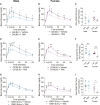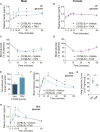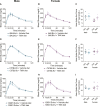Tamoxifen Improves Glucose Tolerance in a Delivery-, Sex-, and Strain-Dependent Manner in Mice
- PMID: 30759201
- PMCID: PMC6424092
- DOI: 10.1210/en.2018-00985
Tamoxifen Improves Glucose Tolerance in a Delivery-, Sex-, and Strain-Dependent Manner in Mice
Abstract
Tamoxifen, a selective estrogen-receptor modulator, is widely used in mouse models to temporally control gene expression but is also known to affect body composition. We report that tamoxifen has significant and sustained effects on glucose tolerance, independent of effects on insulin sensitivity, in mice. IP, but not oral, tamoxifen delivery improved glucose tolerance in three inbred mouse strains. The extent and persistence of tamoxifen-induced effects were sex and strain dependent. These findings highlight the need to revise commonly used tamoxifen-based protocols for gene manipulation in mice by including longer chase periods after injection, oral delivery, and the use of tamoxifen-treated littermate controls.
Copyright © 2019 Endocrine Society.
Figures




References
-
- Metzger D, Chambon P. Site- and time-specific gene targeting in the mouse. Methods. 2001;24(1):71–80. - PubMed
-
- Feil R, Wagner J, Metzger D, Chambon P. Regulation of Cre recombinase activity by mutated estrogen receptor ligand-binding domains. Biochem Biophys Res Commun. 1997;237(3):752–757. - PubMed
-
- Wade GN, Heller HW. Tamoxifen mimics the effects of estradiol on food intake, body weight, and body composition in rats. Am J Physiol. 1993;264(6 Pt 2):R1219–R1223. - PubMed
-
- Guillaume M, Handgraaf S, Fabre A, Raymond-Letron I, Riant E, Montagner A, Vinel A, Buscato M, Smirnova N, Fontaine C, Guillou H, Arnal JF, Gourdy P. Selective activation of estrogen receptor α activation function-1 is sufficient to prevent obesity, steatosis, and insulin resistance in mouse. Am J Pathol. 2017;187(6):1273–1287. - PubMed
-
- Lipscombe LL, Fischer HD, Yun L, Gruneir A, Austin P, Paszat L, Anderson GM, Rochon PA. Association between tamoxifen treatment and diabetes: a population-based study. Cancer. 2012;118(10):2615–2622. - PubMed
Publication types
MeSH terms
Substances
Grants and funding
LinkOut - more resources
Full Text Sources

